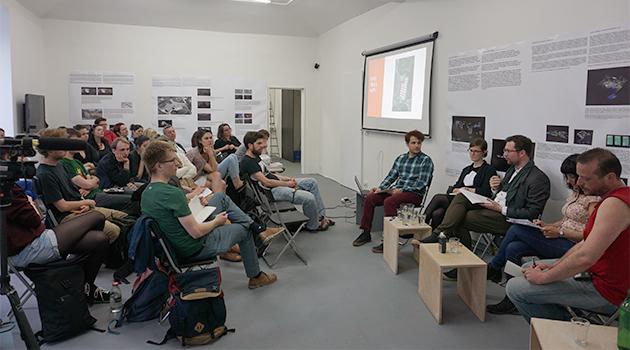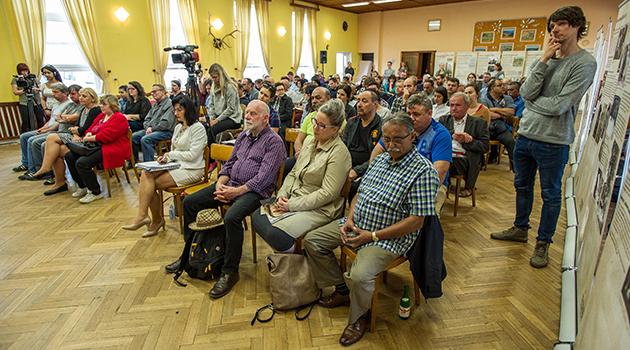Czech memorial to Romani genocide apparently must be done in three years

On Wednesday 18 April at Gallery VI PER in Prague a discussion was held about the process through which the new Lety u Písku memorial is to be created, its possible forms, and the role it should serve. The public debate about these various aspects of memorial creation was enriched by the opinions of the artist Pavel Sterec from the Faculty of Fine Arts at Brno Technical University, the art critic and historian Anežka Bartlová from the College of Arts, Architecture and Design (UMPRUM), and the editor and historian Čeněk Pýcha from the Education Department of the Institute for the Study of Totalitarian Regimes (ÚSTR).
Jana Horváthová, the historian and museologist who is the director of the Museum of Romani Culture, was also part of the discussion panel. The moderator, historian Pavel Baloun, opened the discussion by quoting a headline from the regional newspaper chain Deník.cz: “Definitive end to the Lety scandal? Museum of Romani Culture takes over the pig farm” and said that while the handover of the grounds of the farm to the Museum is an immeasurably important moment in terms of symbolism, the periodically repeating remarks by Czech politicians doubting whether prisoners really suffered there have revealed that the Lety scandal is very much alive.
Baloun questioned whether a “definitive end” could be spoken of when acting Czech Culture Minister Ilja Šmíd told Czech Radio that the ministry is counting on the memorial being finished during 2021, which means that for the archaeological survey, the demolition of the industrial pig farm facility, the design of the architectural competition and the final realization of the memorial there will be just three years. Horváthová then described the course of the handover of the grounds and outlined the schedule for the work that the Museum has put together in collaboration with its establisher, the Culture Ministry.
This year that schedule counts on announcing the selection procedure for the archaeological survey, which should be completed by the end of August. By that same deadline the Museum would like to have cleared away all of the farm equipment, such as the silo, etc.
Depending on the weather, the AGPI firm will probably have removed the remaining slurry from the now-closed facility by the end of September. Unfortunately, documentation of how the farm was built has not been preserved, so the Museum itself will have to commission elaboration of the documentation needed for the demolition work and is planning by the end of April 2019 to open its selection procedure for the firm to perform the demolition by the end of October 2019.
In parallel with these practical steps leading to the demolition of the facility, the Museum will be designing the architectural competition. “Here we will do our best to collaborate with the Czech Chamber of Architects. We want expert cooperation. We will begin, after consultation with some of the artists present here, to organize something like an advisory group to aid us with establishing the commission for the architecture competition by the end of this year. Then, in close cooperation with the Czech Chamber of Architects, we would like to hold the competition,” the director said.
In addition to many other subjects related to designing the memorial and commemorating the former camp, the different roles between a memorial and a museum were discussed as crucial, as were the opportunities for full-fledged participation in the creation of the memorial by the various stakeholders. Anežka Bartlová, editor of The Monument Manual (Manuál monumentů) – a publication in the form of a manual that summarizes the experiences and practical information gleaned by those who have produced memorials and monuments in the Czech Republic – said she considered the distinction between a memorial and a museum to be an essential component of the problem faced by those designing the new Lety installation.
An institution such as a museum could be created at that location, or a memorial could be built there that would purely serve as a remembrance site that would not require the installation of any backup facilities. Each option serves a different function for different audiences.
Čeněk Pýcha observed that while one expects a museum to contextualize, interpret and present history, a memorial is about the opportunity to show respect to victims. In the case of the Lety u Písku memorial a synthesis of both could be achieved.
Pavel Sterec warned that we should not forget that “Compared to a museum, a memorial, especially to such events, is a place that is meant to make it possible for visitors to experience a feeling of sadness, and it should accent that this is a place of contemplation. That is not something that any architectural contest or artistic vision can save us from. It is a specific kind of thinking that is still lacking from the discourse around that site. A synthesis can only happen when we know what sources are being drawn on.”
During the exchange Sterec recalled more than once that what is necessary for the discussion of how to grasp the Lety memorial is not just a sufficient amount of time, but also the expenditure of the necessary financial and material resources, which the Culture Minister’s schedule is not taking into consideration. “I see the role of experts, whether they be architects or artists, as being in coming up with specific proposals for those aspects, as warning that the current plan is not realistic if it’s actually supposed to turn out the way we would all like,” he said.
Čeněk Pýcha mentioned that the Lety u Písku memorial will also have enormous educational potential as a remembrance site. Sterec said the range of information the memorial could communicate is quite broad and that even the most technologically advanced exhibition will never replace the need for qualified staff who will be able to respond to developments and to the specific ages and profiles of the various members of the public who come to the site.
The closing part of the discussion was focused on the opportunity for participatory planning in the design of the memorial. Horváthová assured the audience that despite the lack of financing and time, the Musuem wants to attempt to design the architectural competition on the basis of a broader discussion and that they have reached out, for example, to the city planner Petr Klápště from Czech Technical University, who specializes in designing plans and projects with the participation of their users, to aid the Museum methodologically.
In that context the question was raised of how and where the relatives of the camp victims and the survivors will be involved in the design of the memorial. The Museum has been documenting the Holocaust and its Romani victims since it was established and continues to do so, and has already spoken with many of the families whose members were imprisoned either at Hodonín u Kunštátu or at Lety u Písku, but the director said it was very difficult to motivate them to join the public discussion of the memorial.
Helena Sadílková, head of the Romani Studies Seminar at the Department of Central European Studies at the Faculty of Arts at Charles University then commented on what appearing in public can mean for the relatives of those who were imprisoned in these camps: “Any of those people who is brave enough to begin expressing their opinions about these matters draws attention to themselves and will be labeled as Romani, which can influence their lives rather radically. There are cases of specific people who somehow, through their acknowledgment of this history, have suddenly become targets for attack, or the behavior of the people they normally come into contact with changes because they have identified themselves. That is a terribly important dimension of this and it is necessary to be aware of it if we are meant to discuss how we should remember these people and how they can participate. It means much more for them than just talking about history and participating in the discussion somehow.”
At the close of the discussion Horváthová openly admitted: “We are doing this for the first time. We are just now seeking the way forward.”
The current societal atmosphere, in which elected political representatives are doubting the Holocaust and its Romani victims, is one in which employees of the Museum are now facing an influx of hate mail because they are building the Lety memorial, which certainly does not make the work of the Museum easier. Sterec returned to Baloun’s opening remarks about whether the handover of the former industrial pig farm to the Museum was the definitive end to the Lety scandal, saying: “For me this is about the fact that money is being made available for concrete, but not for participation, and that is a continuation of this society’s allergy to Lety u Písku.”
